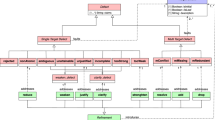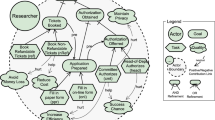Abstract
Non-canonical requirement specifications refer to a set of software requirements that is either inconsistent, vague or incomplete. In this paper, we provide a correspondence between requirement specifications and annotated propositional belief bases. Through this analogy, we are able to analyze the contents of a given set of requirement collections known as viewpoints and specify whether they are incomplete, incoherent, or inconsistent under a closed-world reasoning assumption. Based on the requirement collections’ properties introduced in this paper, we define a viewpoint integration game through which the inconsistencies of non-canonical requirement specifications are resolved. The game consists of several rounds of negotiation and is performed by two main functions, namely choice and enhancement functions. The outcome of this game is a set of inconsistency-free requirement collections that can be integrated to form a unique fair representative of the given requirement collections.
Similar content being viewed by others
References
Amon B, Ekenberg L, Johannesson P, Munguanaze M, Njabili U, Tesha RM (2003) From first-order logic to automated word generation for lyee. Knowl Based Syst 16(7–8): 413–429
Andrade J, Ares J, Garcia R, Pazos J, Rodriguez S, Silva A (2004) A methodological framework for viewpoint-oriented conceptual modeling. IEEE Trans Softw Eng 30(5): 282–294
Arenas M, Bertossi LE, Kifer M (2000) Applications of annotated predicate calculus to querying inconsistent databases. In: Computational Logic’00, pp 926–941
Bagheri E, Ghorbani AA (2007a) A framework for distributed collaborative conceptual model development. In: OOPSLA Companion, pp 785–786
Bagheri E, Ghorbani AA (2007b) On the collaborative development of para-consistent conceptual models. In: Seventh international conference on quality software, 2007. QSIC ’07, pp 336–341
Bagheri E, Ghorbani AA (2008) A belief-theoretic framework for the collaborative development and integration of para-consistent conceptual models. J Syst Softw (to appear)
Bagheri E, Ghorbani AA (2008a) Experiences on the belief-theoretic integration of para-consistent conceptual models. In: Australian software engineering conference, pp 357–366
Bagheri E, Ghorbani AA (2008b) Towards a belief-theoretic model for collaborative conceptual model development. In: The fourty-first Hawaii international conference on system sciences (HICSS’08) IEEE
Balzer R (1991) Tolerating inconsistency, In: ICSE ’91: Proceedings of the 13th international conference on Software engineering. IEEE Computer Society Press, Los Alamitos, CA, USA, pp 158–165
Barr M, Wells C (1990) Category theory for computing science. Prentice-Hall Inc., Upper Saddle River
Belnap ND (1977) A useful four-valued logic. In: Dunn J, Epstein G(eds) Modern uses of multiple-valued logics. Reidel, Dordrecht, pp 8–37
Boehm B, In H (1996) Identifying quality-requirement conflicts. IEEE Softw 13(2): 25–35
Booth R (2006) Social contraction and belief negotiation. Inf Fusion 7(1): 19–34
Cadoli M, Donini FM (1997) survey on knowledge compilation. AI Commun 10(3–4): 137–150
Dardenne A, van Lamsweerde A, Fickas S (1993) Goal-directed requirements acquisition. Sci Comput Program 20(1–2): 3–50
Darke P, Shanks G (1996) Stakeholder viewpoints in requirements definition: a framework for understanding viewpoint development approaches. Requir Eng V1(2): 88–105
Dubois D, Lang J, Prade H (1994) Possibilistic logic, pp 439–513
Easterbrook S (1991) Handling conflict between domain descriptions with computer-supported negotiation. Knowl Acquis 3(3): 255–289
Easterbrook S (1994) Resolving requirements conflicts with computer-supported negotiation. Requirements engineering: social and technical issues, pp 41–65
Easterbrook S, Chechik M (2001) A framework for multi-valued reasoning over inconsistent viewpoints. In: ICSE ’01: Proceedings of the 23rd international conference on software engineering. IEEE Computer Society, Washington, DC, USA, pp 411–420
Fiadeiro JL, Maibaum T (1995) Interconnecting formalisms: supporting modularity, reuse and incrementality. In: SIGSOFT ’95: Proceedings of the 3rd ACM SIGSOFT symposium on Foundations of software engineering. ACM Press, New York, pp 72–80
Finkelstein A, Gabbay D, Hunter A, Kramer J, Nuseibeh B (1994) Inconsistency handling in multiperspective specifications. IEEE Trans Softw Eng 20(8): 569–578
Finkelstein A, Kramer J, Nuseibeh B, Finkelstein L, Goedicke M (1992) Viewpoints: a framework for integrating multiple perspectives in system development. Int J Softw Eng Knowl Eng 2(1): 31–57
Gabbay DM, Hunter A (1991) Making inconsistency respectable: a logical framework for inconsistency in reasoning. In: FAIR ’91: Proceedings of the international workshop on fundamentals of artificial intelligence research. Springer, London, pp 19–32
Gervasi V, Zowghi D (2005) Reasoning about inconsistencies in natural language requirements. ACM Trans Softw Eng Methodol 14(3): 277–330
Ghose A, Lin Q (2006) Viewpoints merging via incrementally elicited ranked structures. In: QSIC, pp 141–150
Goldin L, Berry DM (1997) Abstfinder, a prototype natural language text abstraction finder for use in requirements elicitation. Autom Softw Eng 4(4): 375–412
Ide N, Vronis J (1998) Word sense disambiguation: the state of the art. Comput Linguist 24: 1–40
Jøsang A (2001) A logic for uncertain probabilities. Int J Uncertain Fuzzy Knowl Syst 9(3): 279–212
Josang A, Daniel M, Vannoorenberghe P (2003) Strategies for combining conflicting dogmatic beliefs. In: Proceedings of the sixth international conference of information fusion, pp 1133–1140
Kaiya H, Horai H, Saeki M (2002) Agora: attributed goal-oriented requirements analysis method. In: Requirement engineering conference, p 13
Konieczny S (2004) Belief base merging as a game. J Appl Non-Classical Logics 14(3): 275–294
Kotis K, Vouros A (2006) Human-centered ontology engineering: the hcome methodology. Knowl Inf Syst 10(1): 109–131
Lee L, Ling W (2003) A methodology for structural conflict resolution in the integration of entity-relationship schemas. Knowl Inf Syst 5(2): 225–247
Lehtola L, Kauppinen M, Kujala S (2004) Requirements prioritization challenges in practice. In: PROFES, pp 497–508
Leite JCSP, Freeman PA (1991) Requirements validation through viewpoint resolution. IEEE Trans Softw Eng 17(12): 1253–1269
List C, Goodin RE (2001) Epistemic democracy: generalizing the condorcet jury theorem. J Polit Philos 9(3):277–306. http://www.blackwell-synergy.com/doi/abs/10.1111/1467-9760.00128
Liu W (2006) Measuring conflict between possibilistic uncertain information through belief function theory. In: KSEM, pp 265–277
Liu W, Qi G, Bell DA (2006) Adaptive merging of prioritized knowledge bases. Fundam Inform 73(3): 389–407
Luisa M, Mariangela F, Pierluigi I (2004) Market research for requirements analysis using linguistic tools. Requir Eng 9(1): 40–56
Mu K, Jin Z, Lu R, Peng Y (2007) Handling non-canonical software requirements based on annotated predicate calculus. Knowl Inf Syst 11(1): 85–104
Mu K, Liu W, Jin Z, Lu R, Yue A, Bell DA (2007) A merging-based approach to handling inconsistency in locally prioritized software requirements. In: KSEM, pp 103–114
Mylopoulos J, Borgida A, Jarke M, Koubarakis M (1990) Telos: representing knowledge about information systems. ACM Trans Inf Syst 8(4): 325–362
Nasukawa T, Yi J (2003) Sentiment analysis: capturing favorability using natural language processing. In: K-CAP ’03: Proceedings of the 2nd international conference on Knowledge capture. ACM, New York, pp 70–77
Nuseibeh B, Kramer J, Finkelstein A (1994) A framework for expressing the relationships between multiple views in requirements specification. IEEE Trans Softw Eng 20(10): 760–773
Qi G, Liu W, Bell D (2007) Combining multiple prioritized knowledge bases by negotiation. Fuzzy Sets Syst 158(23): 2535–2551
Qi G, Liu W, Bell DA (2005) Measuring conflict and agreement between two prioritized belief bases. In: IJCAI, pp 552–557
Robinson WN, Pawlowski SD (1999) Managing requirements inconsistency with development goal monitors. IEEE Trans Softw Eng 25(6): 816–835
Ryan K, Karlsson J (1997) Prioritizing software requirements in an industrial setting. In: ICSE ’97: Proceedings of the 19th international conference on software engineering. ACM, New York, pp 564–565
Sabetzadeh M, Easterbrook S (2006) View merging in the presence of incompleteness and inconsistency. Requir Eng 11(3): 174–193
Sommerville I, Rodden T, Sawyer P, Bentley R, Twidale M, (1993) Integrating ethnography into the requirements engineering process. In: Proceedings of IEEE international symposium on requirements engineering, pp 165–173
Sommerville I, Sawyer P (1997) Viewpoints: principles, problems and a practical approach to requirements engineering. Ann Softw Eng V3(0): 101–130
Spanoudakis G, Constantopoulos P (1995) Integrating specifications: a similarity reasoning approach. Autom Softw Eng V2(4): 311–342
Spanoudakis G, Finkelstein A (1997) Reconciling requirements: a method for managing interference, inconsistency and conflict. Ann Softw Eng 3(0):433–457. http://dx.doi.org/10.1023\%2FA\%3A1018998207415
Spanoudakis G, Finkelstein A, Till D (1999) Overlaps in requirements engineering. Autom Softw Eng 6(2): 171–198
Spanoudakis G, Zisman A (2001) Inconsistency management in software engineering: survey and open research issues. Handbook of software engineering and knowledge engineering, vol 1
Tsai J, Weigert T, Jang H-C (1992) A hybrid knowledge representation as a basis of requirement specification and specification analysis. IEEE Trans Softw Eng 18(12): 1076–1100
van Lamsweerde A (2001) Goal-oriented requirements engineering: a guided tour. In: Proceedings of the fifth IEEE international symposium on requirements engineering, pp 249–262
Lamsweerde A, Darimont R, Letier E (1998) Managing conflicts in goal-driven requirements engineering. IEEE Trans Softw Eng 24(11): 908–926
Yager RR (1987) On the Dempster–Shafer framework and new combination rules. Inf Sci 41(2): 93–137
Zafarani R, Jashki M-A, Baghi H, Ghorbani AA (2008) A novel approach for social behavior analysis of the blogosphere. In: Canadian conference on AI, pp 356–367
Zave P, Jackson M (1997) Four dark corners of requirements engineering. ACM Trans Softw Eng Methodol 6(1): 1–30
Zhu X, Jin Z (2005) Ontology-based inconsistency management of software requirements specifications. In: SOFSEM, pp 340–349
Zuckerman M, Kernis MH, Guarnera SM, Murphy JF, Rappoport L (1983) The egocentric bias: seeing oneself as cause and target of others behavior. J Pers 51(4): 621–630
Author information
Authors and Affiliations
Corresponding author
Rights and permissions
About this article
Cite this article
Bagheri, E., Ghorbani, A.A. The analysis and management of non-canonical requirement specifications through a belief integration game. Knowl Inf Syst 22, 27–64 (2010). https://doi.org/10.1007/s10115-008-0187-6
Received:
Revised:
Accepted:
Published:
Issue Date:
DOI: https://doi.org/10.1007/s10115-008-0187-6




